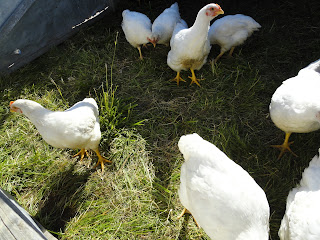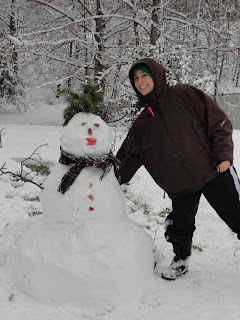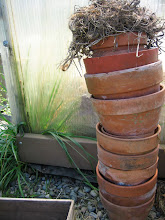Just a quick update on our chicken breed experiment. Generally, the Freedom Rangers were much smaller birds than the Cornish Cross. Although raised under the same conditions and given the same feed, the Freedom Rangers provided substantially less meat. However, during a side-by-side taste comparison, the Rangers took the prize with a noticeably more rich flavor. (Pablo noted the white meat of the Ranger tasted more like the dark meat of a standard chicken. ) I would suggest that in addition to the taste, there is also value in raising birds that are closer to the wild type and not solely selected for rapid growth.
At the beginning of the year, Heritage decided to try raising two different breeds of meat chickens and compare how they fared over the course of the season: Cornish Cross and Freedom Rangers. The Cornish Cross is probably the most well known breed out there, and the farm has had many years of experience working with them. Selected over the years for its fast growth and large quantity of breast meat, this "teenage mutant ninja" bird is not very hearty when placed in mobile pens outside, and in the opinion of this writer, is not the brightest flame in the fire. Freedom Rangers sounded appealing not only for their super-hero-esque name, but also for their active foraging behavior and ability to flourish outside.
The set-up for our broiler chickens. Their pens are moved onto new grass every morning to allow them access to fresh vegetation (and bugs).
I recently sat down with apprentices and chicken care-takers Ian and Julie to ask them some questions regarding the birds. They described how active the Freedom Rangers are compared to the Cornish Cross, and their tendency to fly out of the pens when given the opportunity. "There's one blonde beauty that takes off," remarked Ian. "It's crazy fast." Julie observed "The Cornish Cross are curious. They are not just fatter, they also have a more docile demeanor. I would say Freedom Rangers are prettier, but have bad attitudes." I suggested they were not unlike super models in this way. When asked how she has learned to handle the chickens during her tenure on the farm to, Julie offered this tidbit of advice: "I think they like being sung to. But I don't do that when someone else is around."
Freedom Rangers attempting to make an escape via their feeder.
One thing we did not anticipate was that the Freedom Rangers actually eat more feed than the Cornish Cross. "The Cornish Cross are bigger, but they eat less," explained Ian. Initially, we thought the Freedom Rangers' superior foraging ability would cause them to eat less of the grain we provided. Now we are speculating the more active lifestyle of the Freedom Rangers drives their need for more calories. Although we very much like the idea of raising a "more natural meat bird," there are definitely some trade-offs that need to be factored in to the equation when raising the Freedom Rangers. Final judgement of the two breeds and the energies required to raise them will most likely come only after a side-by-side taste test is carried out.
The more docile Cornish Cross like to stick to the ground.
What's that we're shoveling in the picture, you ask? Well, it's a big pile of cow manure and nettles. We enlisted the help of our enthusiastic interns Sarah and Ian to help turn the pile, a necessary step when preparing barrel compost to improve the fertility of our soil.
Cult ritual? No, we're just working to improve the fertility of our fields! (The bandana over Sarah's face was a fashion choice and not related to the manure.)
Ian uses tongue and groove planks to build an in-ground barrel for the compost preparation.
Gertie, the newest member of our Jersey cow herd, was born to proud mama Emily two weeks ago. She is about two hours old in this family photo, but by now has grown enough to romp around the pasture. Gertie's favorite activities include standing in a hole (previously dug by chickens) and challenging her mom to head-butting contests.
Our 2011 CSA began on Tuesday, the first day with sun in a while. I have heard we are nearing the end of a La Niña cycle, which would explain the colder, wetter temperatures we have be experiencing. We were thankfully still able to fill our members' baskets with various shades of green vegetation, and I think we are all looking forward to when the weather allows a more colorful harvest.
CSA set-up inside the garden shed.
New hoophouse, housing multiple varieties of tomatoes and a trellising system inside.
We completed building a new hoophouse a couple weeks ago, intended to keep heat-loving crops (tomatoes and peppers) happy and hopefully encourage them to produce fruit earlier in the season. The construction process was a learning process, to say the least.
Entrance to one of the two hives. Note the pollen being carried inside by the middle bee.
Our resident honeybees have been busy building as well, as evidenced by the constant traffic in and out of the hives.
Last Thursday, Heritage became home to two new hives of bees. A dedicated bee keeper for the past few years, Pablo built top-bar style hives for our new insect residents, and is nearly done with the shelter (to elevate the hives above the ground, where they can become damp from morning dew, and protect them from rain). The hives have been particularly active during sun breaks over the past few days, and it has been neat to see honeybees on flowers out in the fields when we are working. Today we planted a bed of flowers next to the hives, ensuring the bees a nearby snacking source come summer.
Pablo opens the box in which the bees arrived, while Jim supervises from a safe distance. "Hiving" the bees provided great on-farm entertainment. Note Pablo's professional bee-keeper outfit.
Once the bees have been shaken into the hive, a small capsule containing the queen is suspended inside. The workers then chew through a small plug made of sugar in the capsule, eventually releasing her.
Jim and Sarah do their best bee impression to make our new residents feel at home.
I couldn't be happier with the breaks of sunshine that have heralded in the spring, particularly because I know the weather report calls for more rain soon. Taking advantage of the opportunity, I snapped some shots of the budding and blossoming happening around the fields.
Flowers!
A cabbage transplant that has been moved outside the hoophouse, one of the first this spring.
Raspberry cane buds, I can taste the berries already.
What spring farm blog posting would be complete without at least one baby animal photo? Meet Millie, a NW farm terrier, and the newest addition to the menagerie. As you can plainly see, she is a fierce guard dog. She doesn't let any stranger onto the farm...without trying to lick their face first.
Greetings everyone, Pablo here.
Of course, my first post will be all about me! I want to shamlessly advertise a new website that my brother designed for me www.zoeticseed.com It is where I am selling flower seed that I grew and harvested down in Oregon before I moved up here. I also have a seed rack at our farm stand here, and at Compost It in town.
I know that you might be uncertain about an "online store" or even seeds in general, seeing as how they are so small and everything. To dispel those fears, check out a few seed starting books such as The Maritime Northwest Garden Guide, The Flower Farmer, and Seed Sowing and Saving, as well as Seed to Seed to prepare yourself for a floral adventure. We are entering the "window of opportunity", where everything is possible to plant, and your acreage is the limit!
Of course, my first post will be all about me! I want to shamlessly advertise a new website that my brother designed for me www.zoeticseed.com It is where I am selling flower seed that I grew and harvested down in Oregon before I moved up here. I also have a seed rack at our farm stand here, and at Compost It in town.
This is the seed rack at Heritage Farm
I know that you might be uncertain about an "online store" or even seeds in general, seeing as how they are so small and everything. To dispel those fears, check out a few seed starting books such as The Maritime Northwest Garden Guide, The Flower Farmer, and Seed Sowing and Saving, as well as Seed to Seed to prepare yourself for a floral adventure. We are entering the "window of opportunity", where everything is possible to plant, and your acreage is the limit!
Look, these seeds really do work!
Celosia "Pampas Plume"
The flowers shown above are the first "wave" of flower seedlings. I plan on successively sowing several (a regular tongue twister) batches, that way I can provide flowers to our CSA customers and farmstand regulars throughout the season.
I'd like to introduce our new farm intern. She may be small, but she's willing to work outside in inclement weather.
I thought we were done with snow this winter, but turns out I was wrong. Thankfully, we got the carrots weeded and covered up the day before the island turned into a winter wonderland. Two new heated tables are helping keep the seedlings cozy in the greenhouse, and we are engaging in unanticipated indoor activities until the snow lets up. Scrabble anyone?
On the farm, we are interested in working with biodynamic practices. For those unfamiliar with biodynamics, it is an alternative form of agriculture. It could be said to fall into the "beyond organic" category. Biodynamic farmers pay close attention to the timing of their activities, including when they sow seeds and harvest, to ensure the most favorable conditions for their plants and the farm as a whole. For example, Wednesday was a leaf day on the biodynamic calendar, meaning conditions were most favorable to plant veggies that are characterized by leaf growth. So as seen in the picture, Pablo planted cabbage seed that day. Other days on the calendar are denoted as root (e.g. carrots or beets), fruit (e.g. peas or squash) or flower days.
Pablo planting cabbage seed into flats in the greenhouse. You can see our lettuce seedlings and onion sets in the foreground.
Last autumn some greens were transplanted into our hoophouse in hopes they would be able to overwinter. I ventured into the hoophouse yesterday and was pleased to see the small lettuce, mustard greens and kale plants have grown, perhaps spurred on by the lengthening daylight hours. I stocked our farmstand with a few precious bags of salad mix. Maybe someone else is as excited about wintertime lettuce as I am?
Despite some pretty vicious cold-snaps this winter, some greens survived in our hoophouse.
Callie, one of our barn cats, can't stay out of the limelight as I photograph the salad mix harvested from the hoophouse.
We periodically move the chicken coop onto new ground so the ladies have access to fresh grass and all the bugs they can get their beaks on. They have recently taken up residence behind the barn, where they like to take dust baths under parked tractor implements. The roosters seem to like to have a perch from which to crow.
Our egg-laying flock enjoying a winter sun break. Note the "Now (P)laying" sign on the back of the coop, formerly located above the movie listings on the side of an old theater in Seattle.
At the farm, we think it is very important to make every effort to relate to our animals. Below, Pablo is demonstrating one such effort with our Jersey milk cows.
Rose doesn't mind spending some downtime with Pablo, although Daphnie (standing) looks skeptical.
January has brought a few changes to Heritage Farm, namely that Pablo Feliz and myself, Camryn Pennington, have taken over as the new farm managers. We are looking forward to the growing season and have already begun preparations for the garden.
Visitor Jay displays his handiwork, a new worm bin. The worms love to eat our veggie scraps, and we love the compost they produce.
Close-up of our worm bin residents at work.
Early lettuce seedlings growing in the greenhouse.
Available in the farm stand this week:
Brussel sprouts
Potatoes
Garlic
Pork by the piece
Pastured chicken eggs
Subscribe to:
Posts (Atom)



























